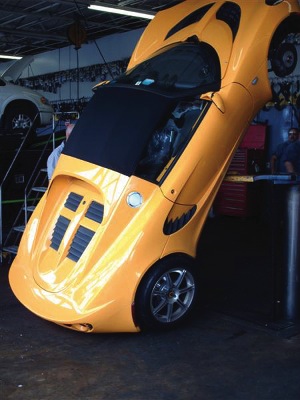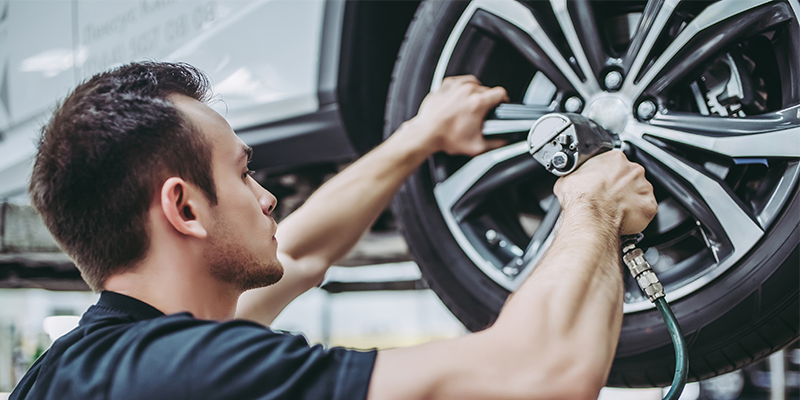 You can only make a few mistakes (see photo) with a lift before it costs more than the lesson is worth. What you don’t know can hurt you if you are using or even buying a lift.
You can only make a few mistakes (see photo) with a lift before it costs more than the lesson is worth. What you don’t know can hurt you if you are using or even buying a lift.
The first thing any tech must do is to know what they are lifting. If possible, look at the sticker on the door jamb to find out the weight of the vehicle and distribution. But never take this number for granted. Look inside the vehicle to see what the driver is carrying and where the weight is situated.
Knowing the weight is essential in determining the center of gravity behind the front wheels. Many truck stops and municipalities have scales that can be used for free. To find center of gravity, divide the rear wheel weight by the overall weight and multiply by the wheelbase (The wheelbase is the measurement from the wheel center not the overall length). Check in the lift manual where the center of gravity of the vehicle should be placed. The placement of the center of gravity will differ on asymmetrical lifts.
A number of lift accidents can be traced to vehicles with unique loads like plumber trucks and vehicles with water or fluid tanks. If in doubt, weigh the vehicle. If you can’t weigh a questionable vehicle, don’t attempt to lift it, or get under it.
The same is true for sports cars and unusual cars like propane powered taxis. Even if the vehicle is light, it does not mean it could be easy to lift. Don’t just kick the swing arm under the vehicle and hope it will hit something solid.
Determining the center of gravity is important. Make sure to refer to the Automotive Lift Institutes lift points guidebook that can be purchased at www.autolift.org. Knowing where to lift the vehicle is becoming important due to some manufacturers using new materials and hydro-forming on some uni-bodies.
Know Your Lift
Once you know what you are lifting, you must know your lift. Your lift is one of the most important tools and can be one of the most dangerous. The manual for the lift should be within reach or even attached to the lift. When a lift fails is when most shops realize that the manual has been lost.
The operating manual is a wealth of information that includes swing arm capacity and maintenance schedules. Most lifts are sold on their overall lift capacity, but this number can become misleading when it comes to real world operation and dealing with two-post lifts. If you are operating a two-post lift, look for the individual lift arm capacity.
With most lifts, all the arms have the same lift capabilities. This means a 10,000-lb. lift will be able to support 2,500 lbs. with each arm. If you have a loaded pickup truck that weighs 8,000 lbs., you would think that the 10,000-lb. two-post lift could easily lift it. You could be dead wrong.
A 10,000-lb. two-post lift has an individual swing arm capacity of 2,500 lbs. If the truck has a weight distribution of 2,500 lbs. over the front axle and 5,500 lbs. over the rear, the lift arms would be overloaded by 500 lbs. It might not sound like much, but when your life is at risk, is not the time to fudge the numbers. You would need an 11,000-lb. lift.
Make sure the vehicle is always resting on the locks or load holding device. Would you get under a vehicle supported just with a jack and no jack stands? So, why would you get under a vehicle that is not firmly resting on the locks of a lift? By having the vehicle on the locks, it is more stable and it reduces the chance of the lifting mechanism being damaged.
Some lifts have a hydraulic pressure gauge/weight gauge that can verify if the vehicle is resting on the locks. Most lifts start to engage locks when the vehicle is more than 19 inches off the ground; this is the ALI “standard.” Some lifts engage sooner for extra safety. Keep this in mind when doing tire rotation on a dually pickup when you are only lifting the vehicle a short distance to perform a tire rotation.
Make sure there is enough room overhead. This goes for when purchasing lifts and when using one. Before you purchase a lift, ask for detailed dimensions. Nothing is worse than putting a box truck or RV through the roof of your shop. Some lifts even include a shut-off bar in the cross member that can prevent accidents. The facts about a lift can be laid bare in the dimensional drawings. Make sure to look at arm height and how far the lift can raise a vehicle from that point. Also, measure the vehicles that your shop currently services.
Buying Lifts
The golden rule of specifying lifts is: Lift unto others as you would lift unto yourself.
If you are responsible for buying new lifts, but will not have to get under them every day, take some time to think about the person who does. Look at the quality of a lift and not just the price. Look at the quality of the materials. Look at the welds on the swing arms and how the pieces are assembled. Also, look at the column bases; bigger is better.
If the welds look like a combination of toothpaste and goober, chances are it will not hold.
Make sure the lift is ALI certified. The Automotive Lift Institute was founded in 1945 as the trade association of U.S. manufacturers of in-ground lifts. ALI’s mission is to promote the safe design, construction, installation, service and use of automotive lifts. ALI, in cooperation with the National Bureau of Standards, sponsored the first standard governing automotive lifts (CS142) in 1947.
ALI does not manufacture lifts. ALI is independent and has the interest of the people who get under the vehicle first. If a lift company or salesperson gets squirmy when you mention ALI, beware!
Look at the reputation of the company selling the lift. Most respectable lift manufacturers will be there even 10 years from now.
The most important thing to consider is how much a lift will cost in the long run. A high-quality lift may cost more up front, but it will save you in terms of repairs and downtime. Also, a high-quality lift will last longer and will not need to be replaced.













